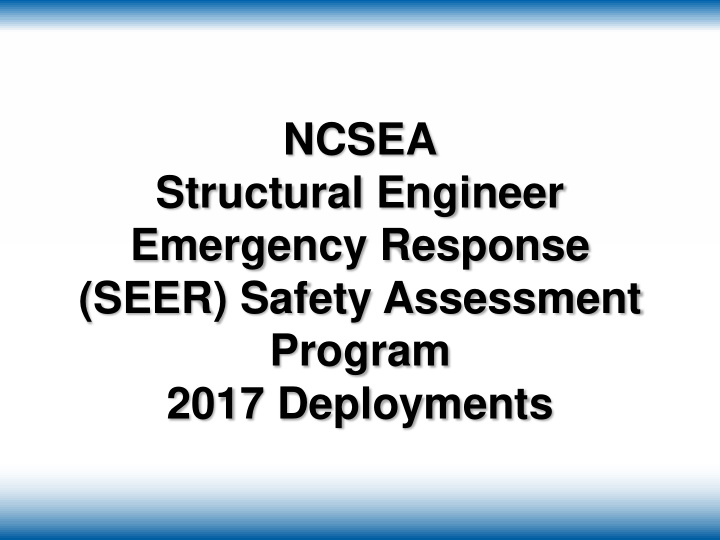



NCSEA Structural Engineer Emergency Response (SEER) Safety Assessment Program 2017 Deployments
2 nd Responders
Why SEER? ▪ All too often affected communities are left without assistance determining whether buildings in the post-disaster environment are adequate for re-occupancy ▪ When evaluations are not performed quickly by properly qualified individuals, residents may reoccupy unsafe buildings ▪ The key is to ensure that qualified damage assessment professionals are available to perform post-disaster damage assessments
Hurricane Harvey Rockport, Texas and Orange Co, Texas NCSEA SEER Team Responses Jeff Kobes and Mike Bratten Structural Engineers Association of TX (SEAoT) Co-chairs for Texas
Rockport, Texas September 9-13 2017 ▪ Approximately 14,000 damaged structures ▪ Saw both severe wind damage and flood/storm surge damage ▪ 51 volunteer assessors over 12 days ▪ Local officials had limited initial response plan. Volunteers with BOAT did great job assisting with the planning and implementation process. ▪ Followed Cal-OES / ATC-45 tagging procedures, with all manual reporting
Rockport, Texas
Rockport, Texas
Rockport, Texas
Rockport, Texas
Rockport, Texas
Rockport, Texas
Rockport, Texas
Rockport, Texas
Orange County, Texas September 23-26 2017 ▪ Approximately 7,500 damaged structures ▪ Predominantly flood damage. Saw very little wind damage ▪ 14 volunteer assessors over first 2 days ▪ Local officials (flood plane manager and GIS coordinator) and BOAT coordinators had very organized response plan. ▪ Assessments were limited to mapped flood plane area within Orange County (no work within the city of Orange) ▪ Used GIS mapped data and digital reporting forms via smartphones/tables/laptops ▪ Generally followed Cal-OES / ATC- 45 for “windshield” only reviews.
Orange County, Texas
Orange County, Texas
Hurricane Irma Glades County, Florida and Monroe County (Florida Keys), Florida SEER Team Responses William Bracken, SEER Co-Chair and Ron Rogers, SEER SME
Overview • On the 10th of September 2017, Hurricane Irma made US landfall in the Florida Keys as a Category 4 hurricane with sustained winds of 130 MPH • Within 48 hours, 84 NCSEA/SEER members from across the country volunteered to provide 2nd Responder assistance • Of those 84, 24 were actively deployed.
Overview, Cont. • 3 Requests Responded To • 4 Municipalities/AHJs Supported • 24 Responders Deployed • 5,032 Structures Assessed • 12 Days Deployed
Areas Assessed Glades Monroe
Glades County ▪ Rural Florida County ▪ 54th lowest per capita income in the FL ▪ Agriculture is the primary industry ▪ 806 sq miles of land area ▪ Population (est.), 13,670 ▪ More than 60% of the structures are manufactured housing
Monroe County ▪ Mixed Urban/Rural Florida County ▪ 4th lowest per capita income in the FL ▪ Tourism and fishing/lobstering are the primary industries ▪ 983 sq miles of land area ▪ Population (est.), 77,482 ▪ Wide variety of housing units including modern construction, historical structures and manufactured homes
The Glades County Mission ▪ September 14 – 16, 2017 ▪ The ATC 45 process was used for evaluation ▪ A Unified Command was established with Glades County at 21:30, Thursday, September 14, 2017 (just over twelve hours after the request was received) ▪ Approximately 90% of the residential structures were assessed
Challenges, Glades Day 1 Day 1 Day 2 Day 2 Day 2 Day 2 Day 2
Typical Damage, Glades
Typical Damage, Glades
Typical Damage, Glades
Typical Damage, Glades
Lessons Learned, Glades ▪ The use of detailed maps of the area with parcels delineated was extremely beneficial ▪ While tape is the preferred method for placard attachment, a stapler is needed for certain applications ▪ All deployed personnel should have some type of task related photo ID
The Monroe County Mission ▪ October 1 – 8, 2017 ▪ A local process loosely based on ATC 45 was used for evaluation ▪ A Unified Command was established with Monroe County at 17:23, Sunday, October 1, 2017 ▪ 100% of the structures were assessed
Challenges
Typical Damage, Monroe
Typical Damage, Monroe
Typical Damage, Monroe
Typical Damage, Monroe
Typical Damage, Monroe
Typical Damage, Monroe
Challenges
Challenges
Lessons Learned 2017 ▪ A non-standard assessment mechanism is not recommended and will cause confusion ▪ Geographically dispersed work areas such as the Keys will impact work time
Recommendations ▪ Deploy a team of personnel to function as an overhead/liaison team ▪ Personnel assigned to the overhead team should have command/deployment experience and a minimum of ICS 300 certification ▪ Develop a rating process for evaluating deployed personnel in order to avoid potential conflict with the local representatives ▪ Use an Inspector number unique to the jurisdiction
Recommendations, Cont. ▪ Develop a tablet/phone based software product in which local ESRI data can be loaded which would allow for an electronic record keeping process in place of the paper forms ESRI Collector for ArcGIS App
Questions ▪ Please visit the SEER website for additional information and to register: ▪ http://www.ncsea.com/resources/emergencyresponse ▪ https://www.ncsea-seer.com
Recommend
More recommend